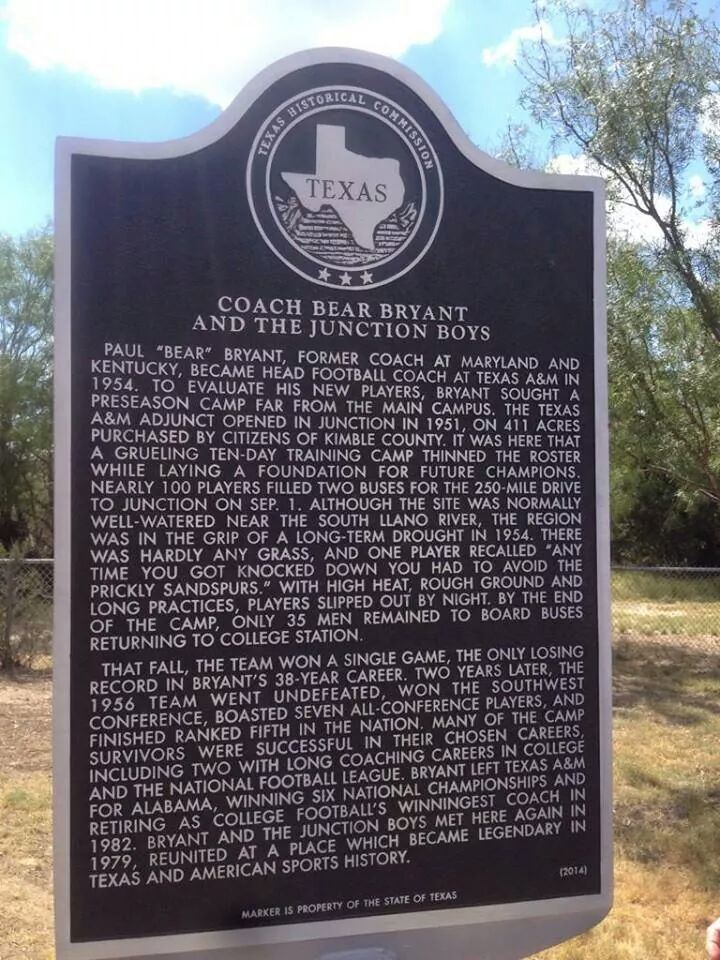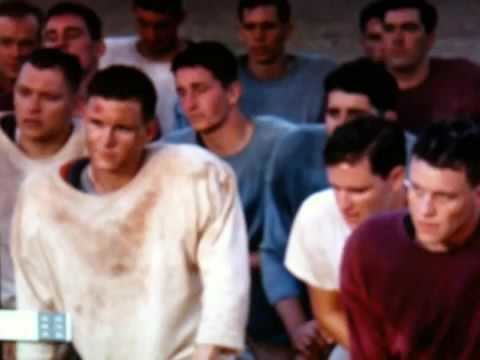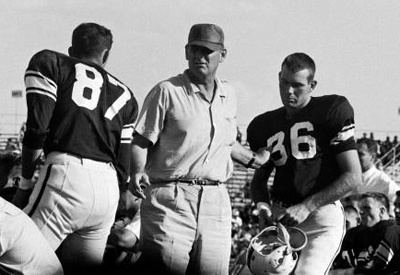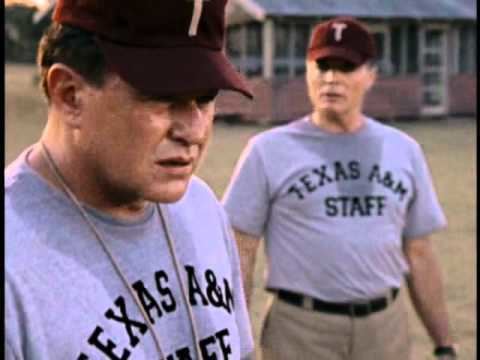Junction Boys
6 /10 1 Votes
| ||||||||||||||||||||||||||||||||||
 | ||||||||||||||||||||||||||||||||||
Junction boys
The Junction Boys were the “survivors” of Texas A&M Aggies football coach Paul “Bear” Bryant’s 10-day summer camp in Junction, Texas, beginning September 1, 1954. The ordeal has achieved legendary status and has become the subject of a 2001 book The Junction Boys by Jim Dent and a television movie with the same name produced by ESPN that starred Tom Berenger as Bryant.
Contents
- Junction boys
- The junction boys con subtitulos
- The camp
- List of survivors
- Impact
- 1954 Schedule and results
- References

The junction boys con subtitulos
The camp

Texas A&M University hired Bear Bryant as head football coach in 1954, replacing former coach Ray George. Bryant arrived in College Station on February 8, 1954, and began cleaning house. He felt that many of the players on the team were weak and not properly trained or coached. He decided that his players needed a camp away from the distractions on campus; thus, he arranged for the camp to be held in the small Hill Country town of Junction, where Texas A&M had a 411-acre (1.7-km²) adjunct campus (now the Texas Tech University Center at Junction).

At the time of the camp, the Hill Country was experiencing an epic drought and heat wave. The drought, the worst in the recorded history of the region, had lasted four years and would last another two after the camp was over. According to the National Climatic Data Center, all 10 days of the camp had hot temperatures with a few days topping 100°F (38°C).

Practices began before dawn and usually lasted all day with meetings in the evening until 11:00 pm. The oppressive heat combined with the brutal practice schedule was too much for many of the players. Each day, fewer and fewer players would be at practice, as many players quit the team from illness or disgust. The situation was compounded by Bryant's refusal to allow water breaks. This practice, which is now widely recognized as dangerous, was at the time commonly employed by coaches at all levels in an attempt to "toughen up" their players. The only relief provided the players were two towels soaked in cold water; one towel was to be shared by the offensive players, and one by the defense. One of the Junction Boys, future NFL coach Jack Pardee, would later say in an interview that it was not unheard of for players to sweat away 10% of their body weight.
List of "survivors"

By the end of the 10-day camp, only a fraction of those who started were left. The list of “survivors” varies from 27 to 35. The Junction Boys listed by writer Jim Dent were:
Over 100 players often have been portrayed as making the trip to Junction. In fact, a smaller number actually went to the camp. Although Bryant started out with over 100 players on the roster, many had already quit or been cut by the time of the Junction camp. Accounts of the exact number who left for Junction vary, but all the survivors insist that it was less than 100.
In 1954, Richard Vick had his photograph taken with Bear Bryant. The photo was featured on the cover of the Houston Chronicle. Today, the photo of Richard Vick and Bear Bryant, as well as Vick's uniform, can be seen at the Texas A&M Sports Museum at Kyle Field.
In 2008, 19 of the Junction Boys had a 54th anniversary reunion at a ranch in Brenham, Texas. The remaining members have agreed to have a reunion every 5 years.
In April 2010, the surviving Junction Boys were honored by the Texas Children's Cancer Center at "An Evening with Texas Legends" in Houston, Texas, at the Hilton Americas Hotel. They were interviewed by legendary sportswriter Mickey Herskowitz at this special event.
Impact
Although the "survivors", as they came to be called, were mentally tougher after the experience, this new strength did not translate into immediate success on the field. In 1954, Texas A&M won only one game against nine losses, the only losing season in Bryant's 38 years as a head coach. In 1956, however, and in spite of a postseason ban, the team finished 9-0-1, punctuated with a win against rival Texas and an end to their Southwest Conference championship drought.
1954 Schedule and results
In 1955, Texas A&M went 7-2-1, and in 1956, the team went 9-0-1 and won the Southwest Conference.
Two of the Junction Boys, Jack Pardee and Gene Stallings, went on to become head coaches in the NFL. Pardee was a two-time All-Pro with the Los Angeles Rams (1963) and the Washington Redskins (1971). Stallings also became Texas A&M head coach, and his Aggie team beat Bryant's Alabama team in the 1968 Cotton Bowl. He later took over Bryant's Crimson Tide and won a national championship in 1992 - Alabama's first national championship since Bryant's death.
